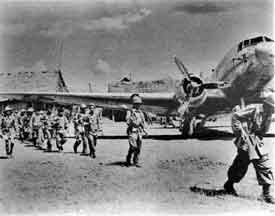1954 Dien Bien Phu Falls
French forces under the command of General Navarre decided that holding Dien Bien Phu, a valley post in Western Vietnam, was a major strategic objective. The French fortified the position with over 30,000 soldiers. On March 15th the Viet Minh began their assault. On May 7th DienBenPhu fell and with it so did French hopes of victory in Vietnam.
The Battle of Dien Bien Phu, a critical event in the First Indochina War, marked the culmination of an extended conflict between French colonial forces and the Viet Minh, the nationalist and socialist revolutionaries led by Ho Chi Minh. This historical encounter unfolded from March to May 1954, set amid the backdrop of the picturesque yet strategic valley of Dien Bien Phu in Western Vietnam.
In late 1953, under the command of General Henri Navarre, the French High Command selected Dien Bien Phu, a remote valley post surrounded by dense, rugged hills, as their principal stronghold. This choice was driven by a belief that holding Dien Bien Phu would inhibit the Viet Minh's access to local resources and their route into Laos. The French also assumed that the geographical challenges would deter the Viet Minh from launching a full-scale attack.
To strengthen this strategic outpost, the French fortified the position with over 30,000 soldiers and established eight separate but interconnected strongpoints. The French forces were a mix of French Foreign Legionnaires, colonial troops from across the French empire, and Vietnamese who supported the French against the communists. The expectation was that the sheer strength of this well-defended base would be enough to repel the Viet Minh forces.
However, the Viet Minh, under the military leadership of General Vo Nguyen Giap, meticulously prepared for this decisive battle. Giap's troops hauled heavy artillery over steep mountains, manually dug a series of tunnels and trenches for shelter and concealment, and planned their assault with careful precision. This preparation turned Dien Bien Phu into a death trap for the French.
On March 13, 1954, the Viet Minh began their assault, employing a strategy of gradual erosion aimed at overrunning one French strongpoint after another. They encircled the valley with artillery, restricting the French forces and cutting off their supply lines. Despite the French having superior weaponry and air support, the Viet Minh's relentless attacks and siege tactics gradually wore down the defenders.
The battle raged for nearly two months, with the Viet Minh systematically capturing the outer French defenses. As their positions fell, the French forces became increasingly demoralized and strained. The harsh conditions, constant artillery barrages, and lack of supplies took a toll on the soldiers.
Finally, on May 7, 1954, after 56 days of intense fighting, the French command inside Dien Bien Phu surrendered. The fall of Dien Bien Phu marked a humiliating defeat for the French forces. The battle not only held military significance, but it also had substantial political repercussions. French hopes of maintaining control over their Indochinese colonies were shattered.
The defeat led to the 1954 Geneva Accords, which ended the First Indochina War and divided Vietnam into North and South along the 17th parallel. Thus, the Battle of Dien Bien Phu was not just a military confrontation but also a catalyst for significant geopolitical change in the region. It demonstrated the capabilities of the Viet Minh and catalyzed the nationalist movements throughout Indochina, marking a pivotal turning point in the struggle for Vietnamese independence.
 >
>